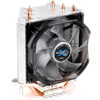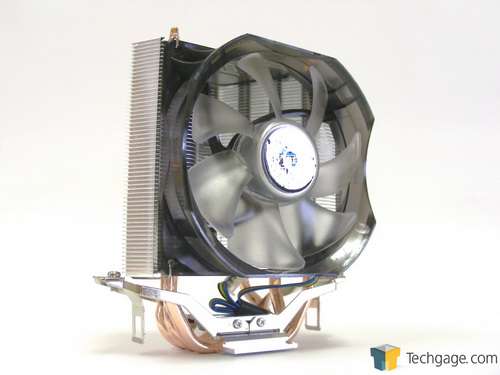- Qualcomm Launches Snapdragon 4 Gen 2 Mobile Platform
- AMD Launches Ryzen PRO 7000 Series Mobile & Desktop Platform
- Intel Launches Sleek Single-Slot Arc Pro A60 Workstation Graphics Card
- NVIDIA Announces Latest Ada Lovelace Additions: GeForce RTX 4060 Ti & RTX 4060
- Maxon Redshift With AMD Radeon GPU Rendering Support Now Available
Zalman CNPS7X LED CPU Cooler Review

Need proof that sufficient CPU cooling doesn’t need to be expensive? The ~$45 Zalman CNPS7X LED is it. Taking after the design of the much more expensive CNPS11X, the CNPS7X uses fewer heatpipes and a smaller 92mm fan, resulting in a modest size and silence – even with a decent CPU overclock under its belt.
Page 1 – Introduction
When it comes to cooling, Zalman needs no introduction. The company has been around long before I first became heavily interested in computers and hardware. From cases to power supplies to GPU coolers, Zalman covers most bases. On the review table today is one of its latest in a long line of CPU coolers, the CNPS7X LED. It offers a twist on a design that has been used sparingly in the past and promises high performance while creating as little noise as possible.
The CNPS7X is the smaller brother of the CNPS11X Extreme. Some of the features have been scaled back a bit, but the overall V-shaped look is still present. The 58 rows of aluminum fins are soldered to the U-shaped copper heatpipes and 56 of them are broken up into two separate sections, one for each end of the heatpipes. The exception are the top and bottom fins that span the entire width and are stamped with the 7X logo to give it a finished look.
With the fan removed, we can see that the center of the cooler is hollow. This may appear strange to some but there is actually a dead spot directly behind the fan motor. Air doesn’t tend to flow well there until it is pushed further away and that’s the reason why some people use spacers between the fans and radiator in water cooling setups. Zalman chose to do away with this area since it would not be efficient, but it provides another bonus in that it keeps the weight of the cooler as minimal as possible.
The number of heatpipes has been reduced from that of the CNPS7X’s bigger brother, but don’t let that get you down because there are still three of them – but they are different than most. Sure, they run through the fins and make up part of the base that directly contacts the CPU but they are also what Zalman calls ‘composite heatpipes’. Each offer different technologies to help with heat transfer; a sintered wick as well as axial grooves to draw liquid back down to the hottest area once it condenses at the top. These composite heatpipes claim to improve heat transfer by 50% when compared to standard ones.
So we know that the base is made up of the heatpipes, but there is also an aluminum block that fits over them to form the rest of the block and fills in the gaps while pulling heat away. The finish on the base is quite good but I was able to find some heavier machine marks, although they are few and far between and would not show up no matter what was done during the photo shoot. When checked with a straight edge on both axis, the CNPS7X was completely flat, however there are very small gaps between where the aluminum block and heatpipes are situated.
The fan has also been reduced to 92mm but retains the blue LEDs. This time, the fan is attached by a wire clip on each side and carries the part number ZE9225BS (ZM5L-PWM). A quick search for any hint of the OEM turned up nothing but the official specifications show that it runs at 1,500 revolutions per minute (RPM) at 20 A-weighted decibels (dBA) in “Quiet Mode” or 1,950 RPM at 25 dBA. There’s no mention of how much air it moves; the static pressure or what type of bearing is used.
The cooler comes ready to install on AMD AM2 and newer systems but for those with Intel systems there are two different mounting platforms included. One is for LGA775 and 1156/1155 while the other is for LGA1366 and both use the push pin method. In a separate bag are four mounting pegs for each Intel platform, a RC33P resistor cable that allows the fan to run in “Quiet Mode”, a small packet of Zalman’s ZM-STG2M Super Thermal Grease, a case badge and fold out instructions.
If we were to go on looks and specifications alone, this is one clean looking cooler with a ton of potential, but it’s up against some stiff competition when installed into our test system.
Support our efforts! With ad revenue at an all-time low for written websites, we're relying more than ever on reader support to help us continue putting so much effort into this type of content. You can support us by becoming a Patron, or by using our Amazon shopping affiliate links listed through our articles. Thanks for your support!











